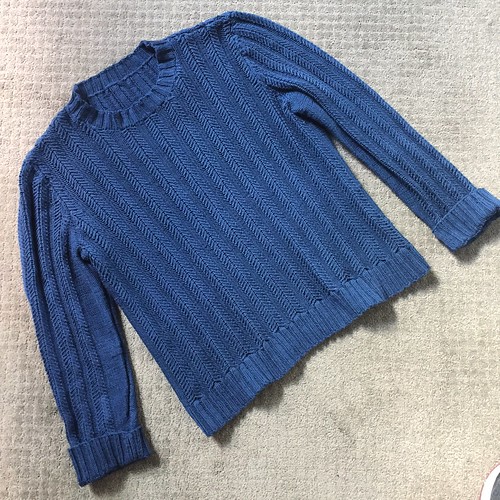A sweater I'd been working on for a while finally came off the needles this week. It's the Barry Pullover designed by Martin Storey.
I'd been thinking about knitting a cotton sweater for a while. When fellow knitters hear that I live in Texas they often assume I'd avoid knitting with wool and would gravitate toward cotton and other "cooler" fibers for knitting. Cotton is indeed the local Texas fiber and runs through my family background. Both of my grandmothers picked their fair share in their childhoods.
And I do like knitting with wool and and am surprised by how comfortable it can be be in even our mild winters. But I loved and missed the chunky cotton sweaters I'd had back in my 80s college days, including one that was mauled by gibbons (long story). So I thought something like this pullover might be fun. And although the rigidity of cotton yarn was a bit hard on my hands, it was a cool project.
The pattern suggested two yarns from Rowan, one a cotton-linen blend which was pretty pricey, and the 100% Handknit Cotton that I chose in a color called Thunder. I wanted this sweater to be oversized, so I chose the 48" chest size to give me some ease. I overshot it. This sweater is big on me - one size down would have been more of what I was looking for. I count 22 ball bands sitting on my table, at 50g each, which matches the finally weight of this sweater: 1.05 kg, or 2 lbs, 5oz. It's pretty bulky! It fits well enough with the sleeves rolled up, so I'm pretty happy with it.
The pattern is a cable rather than the slipped stitch I assumed it was at first glance. The paired cable motifs consist of a single stitch that is carried over three adjacent stitches. In order to make this work, and to create the neat herringbone effect, the carried stitch is wrapped twice around the needle on the previous row. This took me a while a to figure out but soon became second nature. When stretched out, there is a visible gap between in the area toward which the two cables lean, but when I'm wearing it it's not really apparent.
There were two other techniques involved in this sweater that were knew to me, both involving the seaming. The side panels were in reverse stockinette. I wanted to use mattress stitch for these, which I'd never done in reverse. It's a matter of picking up "smiles" on one side and corresponding "umbrellas' on the other, which wasn't too tricky, except on the sleeves with all their increases. But unlike stockinette, where I usually pick up a few stitches on each side of the seam, I figured out that for the reverse stockinette bumps to interlock correctly, I had to seam one-to-one.
For setting the sleeves into the armscyes, I used Andrea's instructions for backstitching a sleeve from the Fruity Knitting Podcast. It worked fairly well, although I wasn't exactly consistent between the two sleeves. Since the backstitching is working on the wrong side, I couldn't tell what the visible join was going to look like until I was all done. There are slight variations between the two sleeves, but nothing I'm going to worry myself about. I'm glad I gave it a try.
In a little nod to wool, in the pictures I'm wearing the Harris Tweed cap I bought while in Scotland recently. Interestingly, I saw more weaving-related activities than knitting ones while there. I'll try to write up a post about the fibery aspects of that trip soon.
Here's to cooler weather arriving soon!




You should have said that the sweater from 1987 was FIRST stolen by a friend and then mauled by Gibbons! I wore that sweater until I moved back to Texas in 1995...
ReplyDeleteOK, after seeing Sharon's comment I really need to know about the gibbons.
ReplyDeleteThe sweater looks great as does the cap! Nice to read the story of that too.
I don't even know about this gibbon story - do tell!
ReplyDeleteI see what you mean about size, but I think you can still style it to make it work. Wow, a whole sweater out of cotton!
This comment has been removed by a blog administrator.
ReplyDeleteSuper
ReplyDeleteI want to communicate with you
ReplyDelete